
Last Updated: 15 January 2025
The United Nations Educational, Scientific and Cultural Organization (UNESCO) designates World Heritage Sites of outstanding universal value to cultural or natural heritage which have been nominated by countries that are signatories to the UNESCO World Heritage Convention, established in 1972.
Cultural Heritage consists of monuments (such as architectural works, monumental sculptures, or inscriptions), groups of buildings, and sites (including archaeological sites).
Natural features (consisting of physical and biological formations), geological and physiographical formations (including habitats of threatened species of animals and plants), and natural sites which are important from the point of view of science, conservation, or natural beauty, are defined as Natural Heritage.
Page Contents
UNESCO World Heritage Sites At A Glance
| No. | State/UT | UNESCO Heritage Sites | Sites |
|---|---|---|---|
| 1 | Assam | 1) Kaziranga National Park (1985) 2) Manas Wildlife Sanctuary (1985) | 2 |
| 2 | Bihar | 1) Mahabodhi Temple (2002) 2) Nalanda Mahavihara (2016) | 2 |
| 3 | Chandigarh | The Architectural Work of Le Corbusier (2016) | 1 |
| 4 | Delhi | 1) Humayun’s Tomb (1993) 2) Qutb Minar (1993) 3) Red Fort (2007) | 3 |
| 5 | Goa | Churches and Convents of Goa (1986) | 1 |
| 6 | Gujarat | 1) Champaner-Pavagadh Archaeological Park (2004) 2) Rani-ki-Vav (2014) 3) Historic City of Ahmadabad (2017) 4) Dholavira (2021) | 4 |
| 7 | Himachal Pradesh | 1) Great Himalayan National Park (2014) 2) Mountain Railways of India (1999) | 2 |
| 8 | Karnataka | 1) Group of Monuments at Hampi (1986) 2) Group of Monuments at Pattadakal (1987) 3) Western Ghats (2012) | 3 |
| 10 | Kerela | Western Ghats (2012) | 1 |
| 11 | Madhya Pradesh | 1) Khajuraho Group of Monuments (1986) 2) Buddhist Monuments at Sanchi (1989) 3) Rock Shelters of Bhimbetka (2003) | 3 |
| 12 | Maharashtra | 1) Ajanta Caves (1983) 2) Ellora Caves (1983) 3) Elephanta Caves (1987) 4) Chhatrapati Shivaji Terminus (2004) 5) Western Ghats (2012) 6) Victorian Gothic & Art Deco Ensembles of Mumbai (2018) | 6 |
| 13 | Odisha | Sun Temple (1984) | 1 |
| 14 | Rajasthan | 1) Keoladeo National Park (1985) 2) The Jantar Mantar (2010) 3) Hill Forts of Rajasthan (2013) 4) Jaipur City (2019) | 4 |
| 15 | Sikkim | Khangchendzonga National Park (2016) | 1 |
| 16 | Tamil Nadu | 1) Group of Monuments at Mahabalipuram (1984) 2) Great Living Chola Temples (1987) 3) Mountain Railways of India (1999) 4) Western Ghats (2012) | 4 |
| 17 | Telangana | Ramappa Temple (2021) | 1 |
| 18 | Uttar Pradesh | 1) Agra Fort (1983) 2) Taj Mahal (1983) 3) Fatehpur Sikri (1986) | 3 |
| 19 | Uttarakhand | Nanda Devi & Valley of Flowers National Parks (1988) | 1 |
| 20 | West Bengal | 1) Sundarbans National Park (1987) 2) Mountain Railways of India (1999) | 2 |
Criteria For Selection In UNESCO World Heritage Sites
(i) Represents a masterpiece of human creative genius.
(ii) Exhibit an important interchange of human values, over a span of time or within a cultural area of the world, on developments in architecture or technology, monumental arts, town planning, or landscape design.
(iii) Bear a unique or at least exceptional testimony to a cultural tradition or to a civilization that is living or which has disappeared.
(iv) An outstanding example of a type of building, architectural or technological ensemble, or landscape that illustrates (a) significant stage(s) in human history.
(v) An outstanding example of a traditional human settlement, land use, or sea use that is representative of a culture (or cultures), or human interaction with the environment especially when it has become vulnerable under the impact of irreversible change.
(vi) Directly or tangibly associated with events or living traditions, with ideas, or with beliefs, with artistic and literary works of outstanding universal significance.
(vii) Contains superlative natural phenomena or areas of exceptional natural beauty and aesthetic importance.
(viii) Outstanding examples representing major stages of earth’s history, including the record of life, significant ongoing geological processes in the development of landforms, or significant geomorphic or physiographic features.
(ix) Outstanding examples representing significant ongoing ecological and biological processes in the evolution and development of terrestrial, freshwater, coastal, and marine ecosystems and communities of plants and animals.
(x) Contains the most significant natural habitats for in-situ conservation of biological diversity, including those containing threatened species of outstanding universal value from the point of view of science or conservation.
| Operational Guidelines | Cultural Criteria | Natural Criteria |
|---|---|---|
| 2002 | (i) (ii) (iii) (iv) (v) (vi) | (i) (ii) (iii) (iv) |
| 2005 | (i) (ii) (iii) (iv) (v) (vi) | (vii) (viii) (ix) (x) |
Fascinating Facts About UNESCO World Heritage Sites
- As of 2025, there are 40 World Heritage Sites located in India. Out of these, 32 are Cultural, 7 are Natural, and one, the Khangchendzonga National Park, is of Mixed Type.
- India has the sixth-largest number of sites in the world.
- India accepted the convention on 14th November 1977, making its sites eligible for inclusion on the list.
- The first sites to be listed were the Ajanta Caves, Ellora Caves, Agra Fort, and Taj Mahal, all of which were inscribed in the 1983 session of the World Heritage Committee.
- The most recent site listed on the UNESCO World Heritage Sites in India was the Dholavira: a Harappan City [Gujarat] and Kakatiya Rudreshwara (Ramappa) Temple [Telangana] in 2021.
- At different times, two sites were listed as endangered: the Manas Wildlife Sanctuary was listed between 1992 and 2011 due to poaching and activities of the Bodo militias, and the monuments at Hampi were listed between 1999 and 2006 due to risks from increased traffic and new constructions in surroundings.
- One site is transnational, The Architectural Work of Le Corbusier is shared with six other countries.
- India has 49 sites on its tentative list. Nominations for the World Heritage List are only accepted if the site was previously listed on the tentative list.
- Maharashtra is the only Indian state with the highest number of UNESCO World Heritage Sites (6 Sites).
- Chandigarh is the only Union Territory to have 1 UNESCO World Heritage Site.
- States like Goa, Kerala, Odisha, Sikkim, Telangana, and Uttarakhand have 1 UNESCO World Heritage Site each.
UNESCO World Heritage Sites In India
1Agra Fort
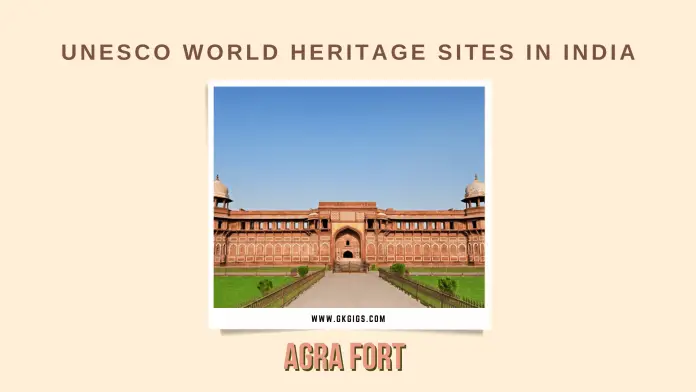
| No. | Header | Details |
|---|---|---|
| 1 | Inscription | 1983 |
| 2 | Location | Agra, Uttar Pradesh |
| 3 | Area | 94 acres (38 ha) |
| 4 | Built | 1565–1573 |
| 5 | Built For | Akbar |
| 6 | Architectural Style | Mughal |
| 7 | Owner | 1) Lodhi Dynasty (1504–1526) 2) Mughal Empire (1526–1540) 3) Suri Dynasty (1540–1555) 4) Mughal Empire (1556–1761) 5) Bharatpur State (1761–1774) 6) Mughal Empire (1774–1785) 7) Maratha Empire (1785–1803) 8) British Empire (1803–1947) 9) Government of India (From 1947) |
| 8 | UNESCO Criteria | Cultural: (iii) |
| 9 | Dossier | 251 |
| 10 | Description | Stylistically, it is one of the high points of Indo-Islamic architecture, with influences from Persian and Timurid architecture. |
2Ajanta Caves
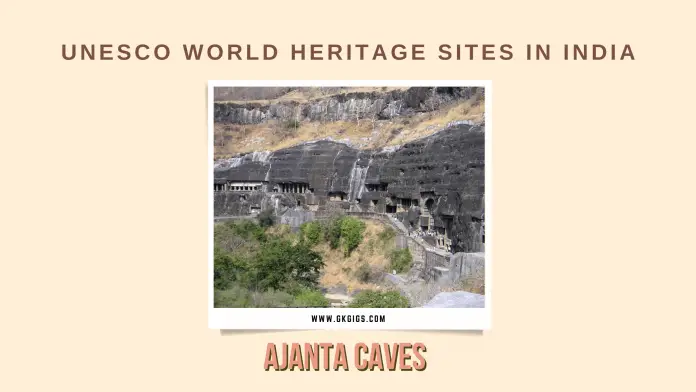
| No. | Header | Details |
|---|---|---|
| 1 | Inscription | 1983 |
| 2 | Location | Ajanta, Aurangabad District, Maharashtra |
| 3 | UNESCO Criteria | Cultural: (i) (ii) (iii) (vi) |
| 4 | Property | 8,242 ha |
| 5 | Buffer Zone | 78,676 ha |
| 6 | Dossier | 242 |
| 7 | Description | The monuments are masterpieces of Buddhist art and exhibited strong influence in India and in the broader region, especially in Java. |
3Buddhist Monuments at Sanchi
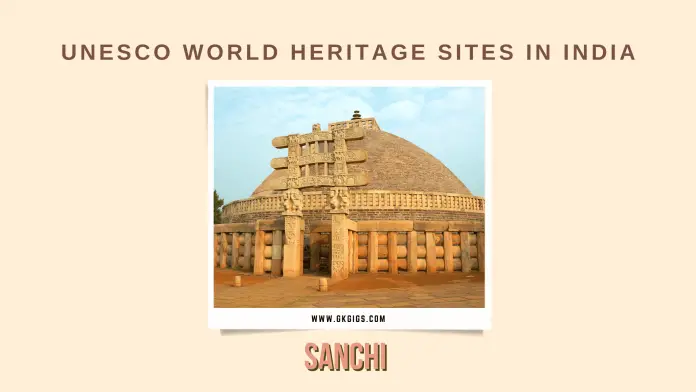
| No. | Header | Details |
|---|---|---|
| 1 | Inscription | 1989 |
| 2 | Location | Sanchi Town, Raisen District, Madhya Pradesh |
| 3 | Type | Stupa and Surrounding Buildings |
| 4 | Architectural style | Buddhist, Mauryan |
| 5 | Construction Started | 3rd Century BCE |
| 6 | UNESCO Criteria | Cultural: (i) (ii) (iii) (iv) (vi) |
| 7 | Height | 16.46 m (54.0 ft) |
| 8 | Diameter | 36.6 m (120 ft) |
| 9 | Dossier | 524 |
| 10 | Official Name | Buddhist Monument at Sanchi |
| 11 | Description | Sanchi is one of the oldest extant Buddhist sanctuaries and was instrumental in the spread of the religion through the Indian subcontinent. |
4Champaner-Pavagadh Archaeological Park
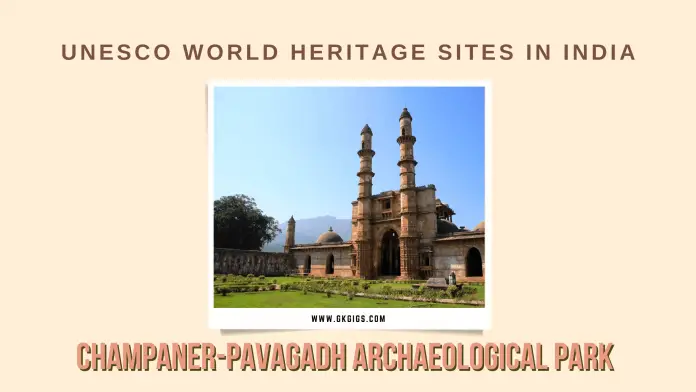
| No. | Header | Details |
|---|---|---|
| 1 | Inscription | 2004 |
| 2 | Location | Panchmahal District, Gujarat |
| 3 | UNESCO Criteria | Cultural: (iii) (iv) (v) (vi) |
| 4 | Property | 1,328.89 ha |
| 5 | Buffer Zone | 2,911.74 ha |
| 6 | Dossier | 1101 |
| 7 | Description | The site contains remains from several periods, from the Chalcolithic to the remains of Champaner, a short-lived capital of the Gujarat Sultanate in the 16th century. |
5Chhatrapati Shivaji Terminus
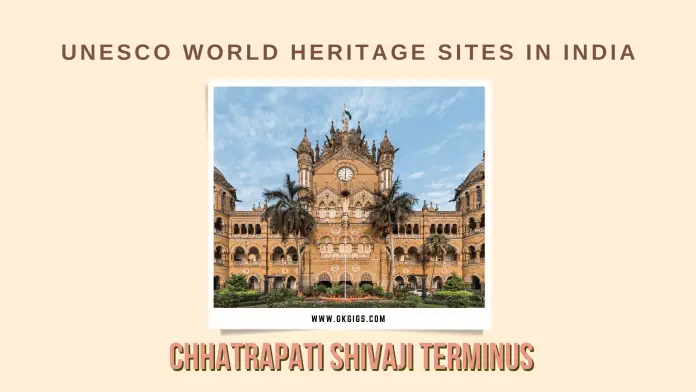
| No. | Header | Details |
|---|---|---|
| 1 | Inscription | 2004 |
| 2 | Location | Fort, Mumbai, Maharashtra |
| 3 | Formerly | → Victoria Terminus → Bori Bunder Railway Station |
| 4 | Official Name | Chhatrapati Shivaji Maharaj Terminus |
| 5 | Architectural Style | Indo-Saracenic Victorian Gothic Revival |
| 6 | Construction Started | 1878 |
| 7 | Construction Completed | May 1888 |
| 8 | Cost | ₹1,614,000 |
| 9 | Client | Central Railway |
| 10 | Architect(s) | Frederick William Stevens, Axel Haig |
| 11 | Engineer | Wilson Bell |
| 12 | UNESCO Criteria | Cultural: (ii) (iv) |
| 13 | Property | 2.85 ha |
| 14 | Buffer Zone | 90.21 ha |
| 15 | Dossier | 945rev |
| 16 | Description | Chhatrapati Shivaji Terminus symbolized the wealth of Mumbai as a major commercial port within the British Commonwealth. |
6Churches and Convents of Goa
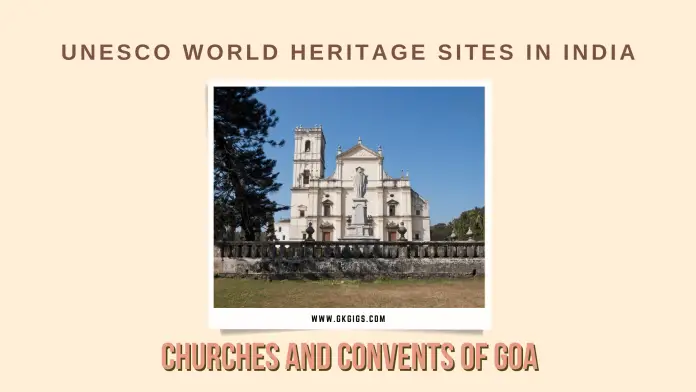
| No. | Header | Details |
|---|---|---|
| 1 | Inscription | 1986 |
| 2 | Location | Goa Velha, Goa |
| 3 | UNESCO Criteria | Cultural: (ii) (iv) (vi) |
| 4 | Dossier | 234 |
| 5 | Description | The site comprises 7 churches & convents that were built in the 16th and 17th centuries in Gothic, Manueline, Mannerist, and Baroque styles, but were also adapted to suit the local techniques and resources. The Basilica of Bom Jesus, where Saint Francis Xavier is buried here. |
7Dholavira
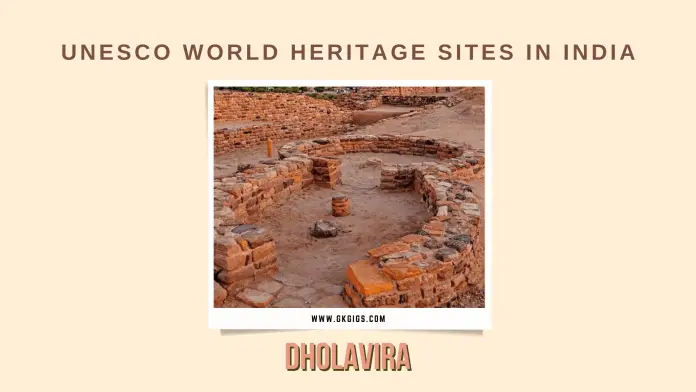
| No. | Header | Details |
|---|---|---|
| 1 | Inscription | 2021 |
| 2 | Location | Khadirbet, Kutch District, Gujarat |
| 3 | Type | Settlement |
| 4 | Area | 47 ha (120 acres) |
| 5 | Periods | Harappa 1 to Harappa 5 |
| 6 | Cultures | Indus Valley Civilization |
| 7 | Condition | Ruined |
| 8 | Official name | Dholavira: A Harappan City |
| 9 | UNESCO Criteria | Cultural: (iii) (iv) |
| 10 | Property | 103 ha |
| 11 | Buffer Zone | 4,865 ha |
| 12 | Dossier | 1645 |
| 13 | Description | Dholavira was one of the centers of the Harappan Civilisation in the Bronze Age from the 3rd to mid-2nd millennium BCE. The site was rediscovered in 1968. |
8Elephanta Caves
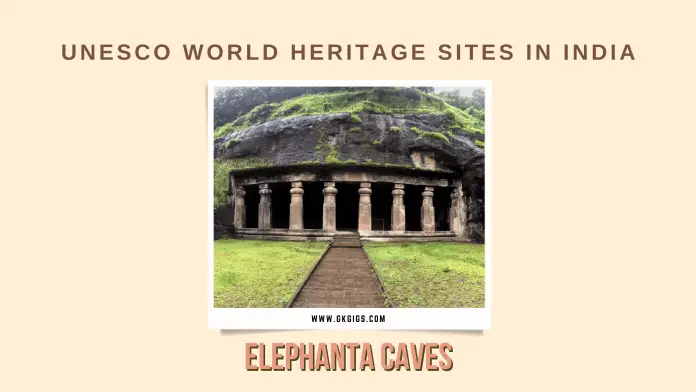
| No. | Header | Details |
|---|---|---|
| 1 | Inscription | 1987 |
| 2 | Location | Elephanta Island, Maharashtra |
| 3 | UNESCO Criteria | Cultural: (i) (iii) |
| 4 | Dossier | 244rev |
| 5 | Description | The cave complex, located on Elephanta Island in Mumbai Harbour, was constructed mainly in the 5th and 6th centuries, with remains of human occupation dating back to the 2nd century BCE. |
9Ellora Caves
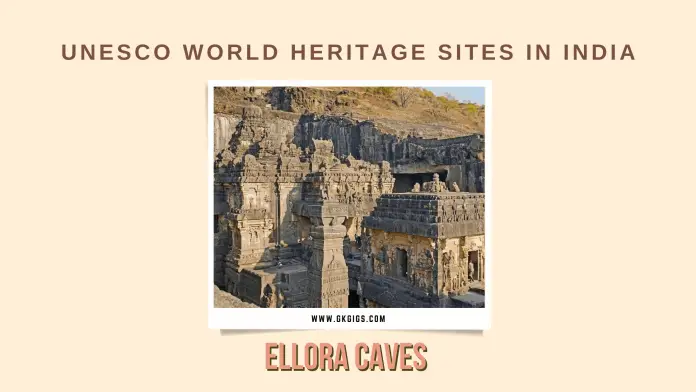
| No. | Header | Details |
|---|---|---|
| 1 | Inscription | 1983 |
| 2 | Location | Aurangabad District (now Sambhaji Nagar District), Maharashtra |
| 3 | Type | Monolithic caves |
| 4 | Area | Ameican |
| 5 | UNESCO Region | Asia-Pacific |
| 6 | UNESCO Criteria | Cultural: (i) (iii) (vi) |
| 7 | Dossier | 243 |
| 8 | Description | Ellora Caves comprise 34 temples and monasteries that were cut into a 2 km (1.2 mi) long basalt cliff between the 7th and 11th centuries. |
10Fatehpur Sikri

| No. | Header | Details |
|---|---|---|
| 1 | Inscription | 1986 |
| 2 | Location | Agra, Uttar Pradesh |
| 3 | Founded By | Akbar |
| 4 | UNESCO Criteria | Cultural: (ii) (iii) (iv) |
| 5 | Dossier | 255 |
| 6 | Description | Fatehpur Sikri was the capital of the Mughal Empire under Emperor Akbar until the capital was moved to Lahore in 1585 and the city was mostly abandoned. |
Related: List Of Chief Justice Of India (2025 Updated)
11Great Himalayan National Park Conservation Area
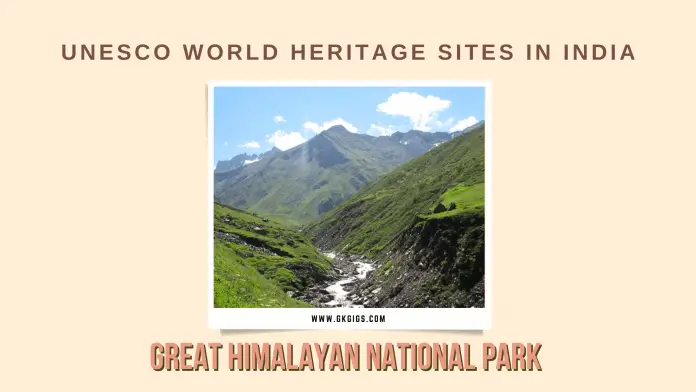
| No. | Header | Details |
|---|---|---|
| 1 | Inscription | 2014 |
| 2 | Location | Himachal Pradesh |
| 3 | Area | 1,171 km2 |
| 4 | Established | 1984 |
| 5 | Region | Asia-Pacific |
| 6 | UNESCO Criteria | Natural: (x) |
| 7 | Property | 90,540 ha |
| 8 | Buffer Zone | 26,560 ha |
| 9 | Dossier | 1406rev |
| 10 | Description | The national park covers habitats from alpine peaks of the Himalayas above 6,000 m (20,000 ft) to alpine meadows and riverine forests below 2,000 m (6,600 ft). In total, there are 25 types of forests recorded, and it is home to endangered species such as the western tragopan and musk deer. |
12Great Living Chola Temples
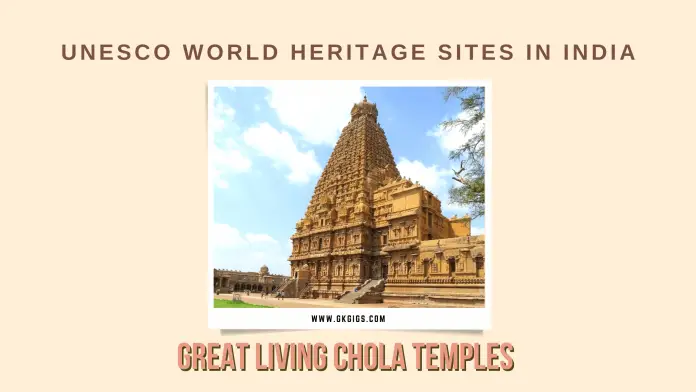
| No. | Header | Details |
|---|---|---|
| 1 | Inscription | 1987 |
| 2 | Location | Tamil Nadu |
| 3 | Boundary Modification | 2004 |
| 4 | Includes | 1) The Brihadisvara Temple Complex, Thanjavur 2) The Brihadisvara Temple Complex, Gangaikondacholapuram 3) The Airavatesvara Temple Complex, Kumbakonam |
| 5 | Area | 21.88 ha (54.1 acres) |
| 6 | UNESCO Criteria | Cultural: (ii) (iii) |
| 7 | Property | 21.74 ha |
| 8 | Buffer Zone | 16.715 ha (41.30 acres) |
| 9 | Dossier | 250bis |
| 10 | Description | Great Living Chola Temples represent some of the best examples of Dravidian architecture of the Chola period. They are made of stone and decorated with stone and bronze sculptures. |
13Group of Monuments at Hampi
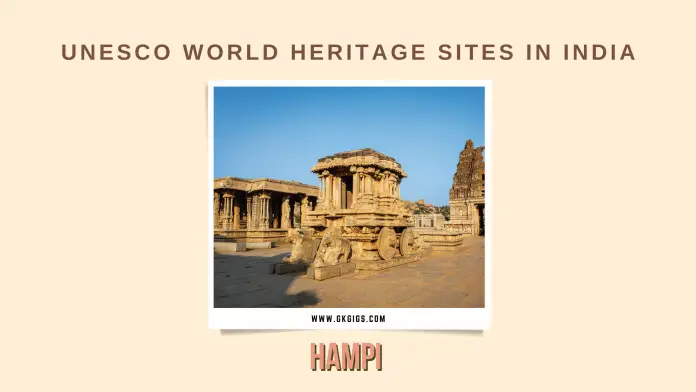
| No. | Header | Details |
|---|---|---|
| 1 | Inscription | 1986 |
| 2 | Location | Hampi, Vijayanagara District, Karnataka |
| 3 | Boundary Modification | 2012 |
| 4 | Includes | Virupaksha Temple |
| 5 | Endangered | 1999–2006 |
| 6 | UNESCO Criteria | Cultural: (i) (iii) (iv) |
| 7 | Property | 4,187.24 ha |
| 8 | Buffer Zone | 19,453.62 ha |
| 9 | Dossier | 241bis |
| 10 | Description | Hampi was the capital of the Vijayanagara Empire until its abandonment after the sacking and pillaging by the Deccan sultanates in 1565. |
14Group of Monuments at Mahabalipuram
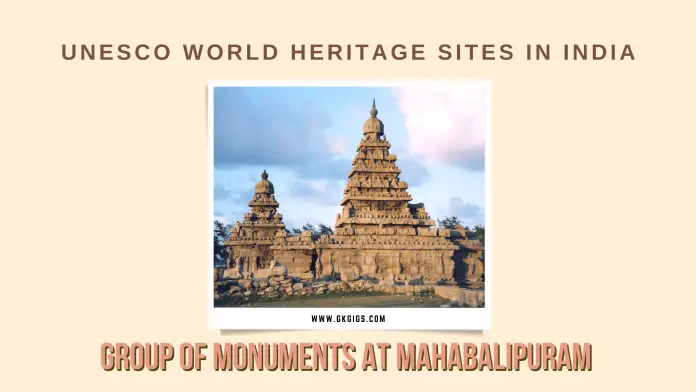
| No. | Header | Details |
|---|---|---|
| 1 | Inscription | 1984 |
| 2 | Location | Mahabalipuram, Chengalpattu District, Tamil Nadu |
| 3 | Includes | 1) The main complex of Mahabalipuram a) Pancha Rathas b) Ganesha Ratha c) Cave Temples d) Descent of the Ganges e) Shore Temple f) Olakkannesvara Temple 2) Mukunda Nayanar Temple 3) Pidari Ratha / Valian Kuttai Ratha |
| 4 | UNESCO Criteria | Cultural: (i) (ii) (iii) (vi) |
| 5 | Dossier | 249 |
| 6 | Description | The artistic expression of the monuments was influential in the broader region, including Cambodia, Vietnam, and Java. |
15Group of Monuments at Pattadakal
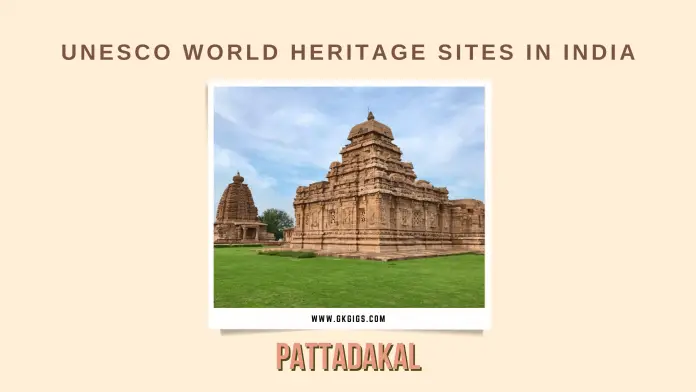
| No. | Header | Details |
|---|---|---|
| 1 | Inscription | 1987 |
| 2 | Location | Bagalkot District, Karnataka |
| 3 | Region | Asia-Pacific |
| 4 | UNESCO Criteria | Cultural: (iii) (iv) |
| 5 | Property | 5.56 ha |
| 6 | Buffer Zone | 113.48 ha |
| 7 | Dossier | 239rev |
| 8 | Description | This site comprises 9 Hindu and 1 Jain temple that was built in the 7th and 8th centuries under the Chalukya dynasty. They were constructed in the Badami Chalukya style that blends influences from northern and southern India. |
16Hill Forts of Rajasthan
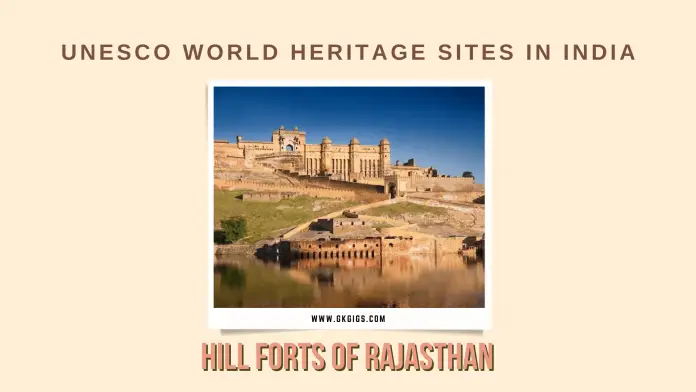
| No. | Header | Details |
|---|---|---|
| 1 | Inscription | 2013 |
| 2 | Location | Rajasthan |
| 3 | Includes | 1) Chittor Fort 2) Kumbhalgarh Fort 3) Ranthambore Fort 4) Gagron Fort 5) Amber Fort 6) Jaisalmer Fort |
| 4 | UNESCO Criteria | Cultural: (ii) (iii) |
| 5 | Property | 736 ha |
| 6 | Buffer Zone | 3,460 ha |
| 7 | Dossier | 247rev |
| 8 | Description | Hill Forts of Rajasthan are eclectic in style, with elements of the Sultanate and Mughal architecture, and were influential on the later styles of the Maratha Empire. They are situated in different settings, for example, Ranthambore is in a forest, and Jaisalmer is in a desert. |
17Historic City of Ahmadabad
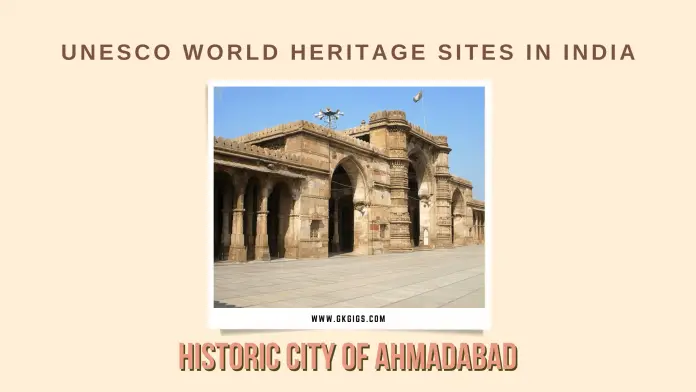
| No. | Header | Details |
|---|---|---|
| 1 | Inscription | 2017 |
| 2 | Location | Ahmedabad District, Gujarat |
| 3 | Established | 1411 |
| 4 | Founded By | Ahmad Shah I |
| 5 | UNESCO Criteria | Cultural: (ii) (v) |
| 6 | Property | 535.7 ha |
| 7 | Buffer Zone | 395 ha |
| 8 | Dossier | 1551 |
| 9 | Description | The architecture is based on timber, and the typical neighborhoods are called pols, densely packed traditional houses with gated streets. |
18Humayun’s Tomb
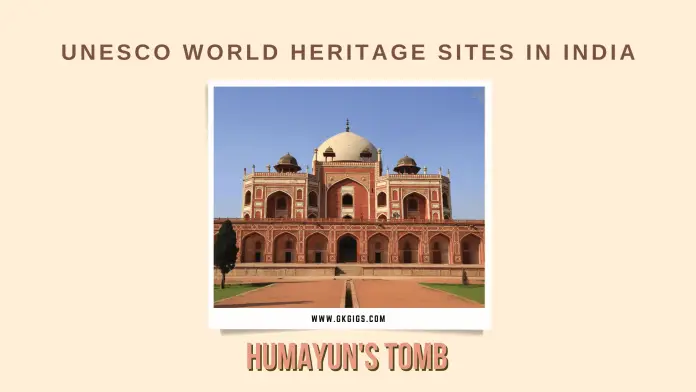
| No. | Header | Details |
|---|---|---|
| 1 | Inscription | 1993 |
| 2 | Location | Mathura road, Nizamuddin East, Delhi |
| 3 | Boundary Modification | 2016 |
| 4 | Type | Tomb |
| 5 | Architectural Style | Mughal |
| 6 | Groundbreaking | 1558 |
| 7 | Architect | Mirak Mirza Ghiyath Sayyed Muhammad |
| 8 | Official Name | Humayun’s Tomb, Delhi |
| 9 | UNESCO Criteria | Cultural: (ii) (iv) |
| 10 | Property | 27.04 ha |
| 11 | Buffer Zone | 53.21 ha |
| 12 | Dossier | 232bis |
| 13 | Description | The monumental double-domed mausoleum represents a leap in Mughal architecture and is an architectural predecessor of the Taj Mahal. |
19Jaipur City
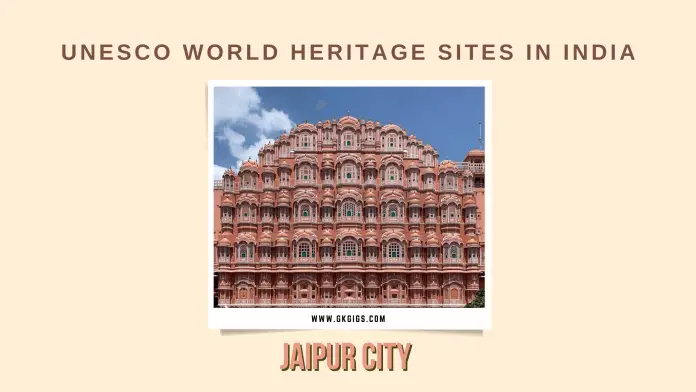
| No. | Header | Details |
|---|---|---|
| 1 | Inscription | 2019 |
| 2 | Location | Jaipur District, Rajasthan |
| 3 | Establishment | 1727 |
| 4 | Founded By | Jai Singh II |
| 5 | Named For | Jai Singh II |
| 6 | Area | 467 km2 |
| 7 | Elevation | 431 m (1,414 ft) |
| 8 | Demonym(s) | Jaipuri, Jaipuriya |
| 9 | Official Language | Hindi |
| 10 | GDP Nominal | ₹ 1,22,140 crores (2020-21) |
| 11 | Region | Southern Asia |
| 12 | UNESCO Criteria | Cultural: (ii) (iv) (vi) |
| 13 | Property | 710 ha |
| 14 | Buffer Zone | 2,205 ha |
| 15 | Dossier | 1605 |
| 16 | Description | The city was built with a grid plan, which was inspired both by ancient Hindu and Western ideals, in a departure from the medieval architecture of the region. |
20Jantar Mantar
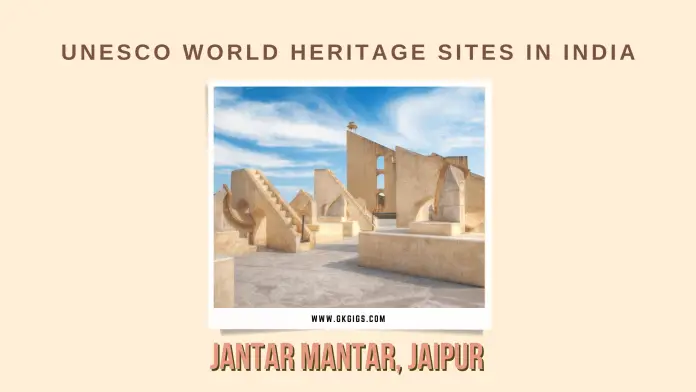
| No. | Header | Details |
|---|---|---|
| 1 | Inscription | 2010 |
| 2 | Location | Jaipur, Rajasthan |
| 3 | UNESCO Criteria | Cultural: (iii) (iv) |
| 4 | Property | 1.8652 ha |
| 5 | Buffer Zone | 14.6664 ha |
| 6 | Dossier | 1338 |
| 7 | Description | It dates from the early 18th century, from the late Mughal period. There are about 20 astronomical instruments that were designed and built for naked-eye observations of the positions of stars and planets. |
Related: 140+ ISRO Quiz Questions And Answers (2025 Updated)
21Kaziranga National Park
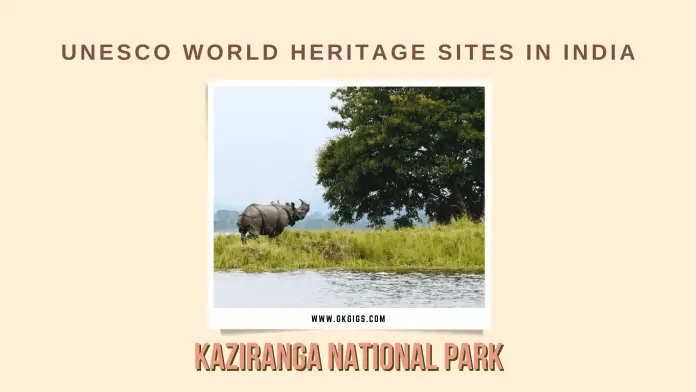
| No. | Header | Details |
|---|---|---|
| 1 | Inscription | 1985 |
| 2 | Location | Golaghat & Nagaon District, Assam |
| 3 | Area | 430 km2 |
| 4 | Established | 1905 |
| 5 | National Park | 1974 |
| 6 | UNESCO Criteria | Natural: (ix) (x) |
| 7 | Property | 42,996 ha |
| 8 | Dossier | 337 |
| 9 | Governing body | Government of Assam Government of India |
| 10 | Description | Kaziranga National Park is one of the best wildlife sanctuaries in the world, home to the world’s largest population of the Indian rhinoceros, as well as tiger, Asian elephant, wild water buffalo, and the Ganges river dolphin. |
22Keoladeo National Park
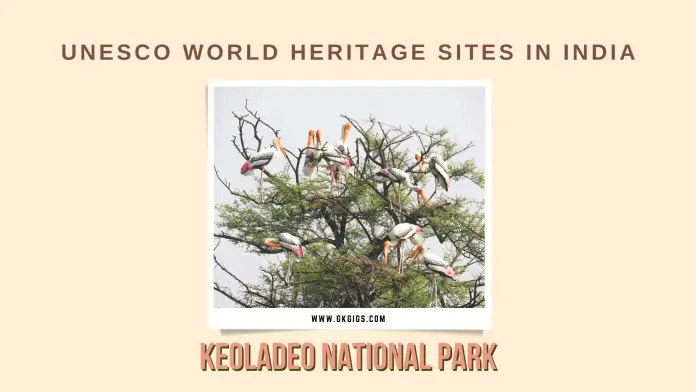
23Khajuraho Group of Monuments
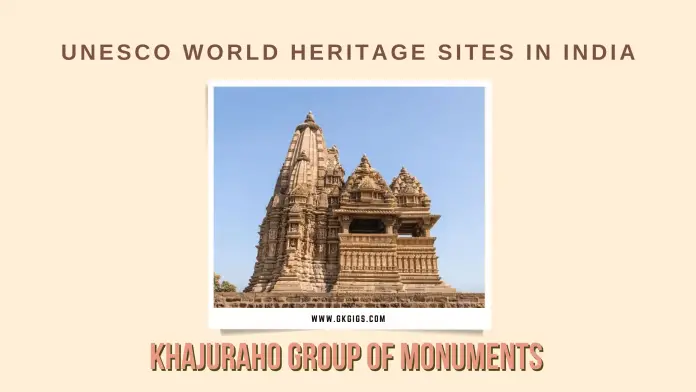
| No. | Header | Details |
|---|---|---|
| 1 | Inscription | 1986 |
| 2 | Location | Chhatarpur, Madhya Pradesh |
| 3 | UNESCO Criteria | Cultural: (i) (iii) |
| 4 | Dossier | 240 |
| 5 | Description | This site comprises 23 temples, both Hindu and Jain, that were built in the 10th and 11th centuries, during the Chandela dynasty. The temples are built in the Nagara style. |
24Khangchendzonga National Park
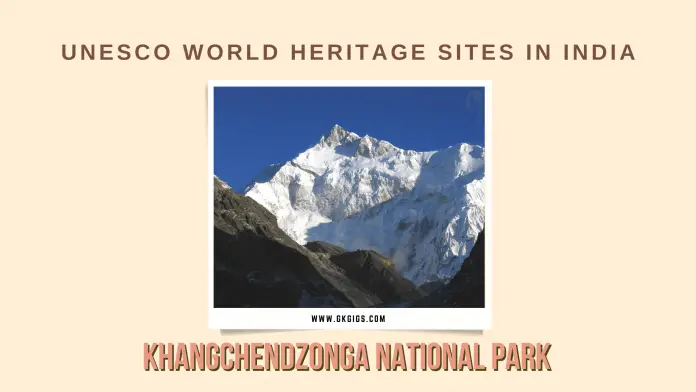
| No. | Header | Details |
|---|---|---|
| 1 | Inscription | 2016 |
| 2 | Location | North Sikkim, Sikkim |
| 3 | Nearest City | Chungthang |
| 4 | Area | 1,784 km2 |
| 5 | Established | 1977 |
| 6 | UNESCO Criteria | Mixed: (iii) (vi) (vii) (x) |
| 7 | Property | 178,400 ha |
| 8 | Buffer Zone | 114,712 ha |
| 9 | Dossier | 1513 |
| 10 | Governing Body | Ministry of Environment & Forests Government of India |
| 11 | Description | The national park is located around Mount Khangchendzonga, the world’s third-highest mountain (8,586 m (28,169 ft)). |
25Mahabodhi Temple
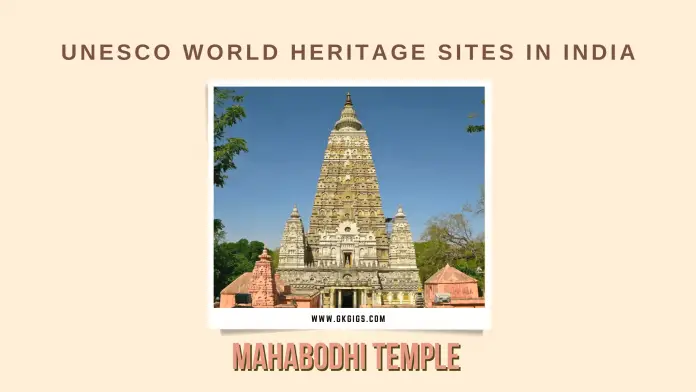
| No. | Header | Details |
|---|---|---|
| 1 | Inscription | 2002 |
| 2 | Location | Bodh Gaya, Bihar |
| 3 | UNESCO Criteria | Cultural: (i) (ii) (iii) (iv) (vi) |
| 4 | Property | 4.86 ha |
| 5 | Dossier | 1056rev |
| 6 | Description | The Buddhist temple complex marks the site where Buddha is said to have attained enlightenment under the Bodhi Tree. |
26Manas Wildlife Sanctuary

| No. | Header | Details |
|---|---|---|
| 1 | Inscription | 1985 |
| 2 | Location | Chirang and Baksa District, BTR, Assam |
| 3 | Nearest City | Barpeta, Assam |
| 4 | Area | 500 Km2 |
| 5 | Established | 1990 |
| 6 | UNESCO Criteria | Natural: (vii) (ix) (x) |
| 7 | Property | 39,100 ha |
| 8 | Region | Asia-Pacific |
| 9 | Dossier | 338 |
| 10 | Endangered | 1992–2011 |
| 11 | Governing Body | Ministry of Environment & Forests Government of India |
| 12 | Description | The area is a biodiversity hotspot & home to several endangered species, including the Indian rhinoceros, Asian elephants, Wild water buffaloes, tiger, sloth bear, pygmy hog, Gee’s golden langur, and the Bengal florican. |
27Mountain Railways of India
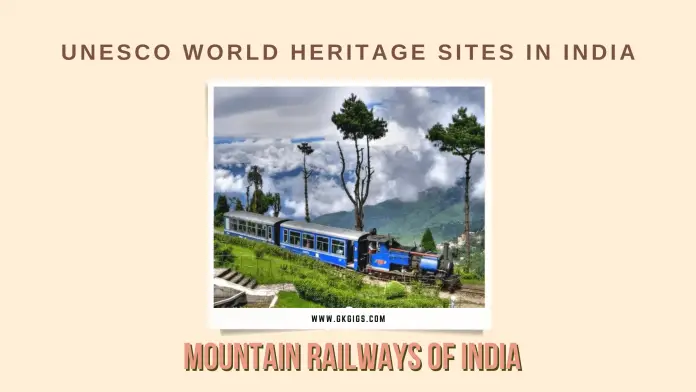
| No. | Header | Details |
|---|---|---|
| 1 | Inscription | 1999 |
| 2 | Location | West Bengal, Tamil Nadu, Himachal Pradesh |
| 3 | Boundary Modification | 2005, 2008 |
| 4 | Includes | 1) Darjeeling Himalayan Railway 2) Nilgiri Mountain Railway 3) Kalka–Shimla Railway |
| 5 | UNESCO Criteria | Cultural: (ii) (iv) |
| 6 | Property | 88.99 ha |
| 7 | Buffer Zone | 644.88 ha |
| 8 | Dossier | 944ter |
| 9 | Description | The Darjeeling Himalayan Railway was initially listed alone in 1999. The Nilgiri Mountain Railway was added in 2005 and the Kalka–Shimla railway in 2008. |
28Nalanda Mahavihara
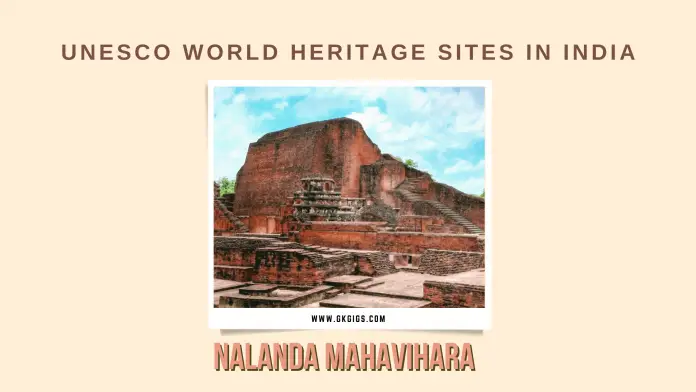
| No. | Header | Details |
|---|---|---|
| 1 | Inscription | 2016 |
| 2 | Location | Nalanda District, Bihar |
| 3 | Region | Magadha |
| 4 | Type | Centre of Learning, Ancient University |
| 5 | Dimensions | 240 m (L) 490 m (W) |
| 6 | Area | 12 ha (30 acres) |
| 7 | Builder | King Kumaragupta I |
| 8 | Founded | 5th Century |
| 9 | Abandoned | 13th Century |
| 10 | Cultures | Buddhism |
| 11 | Ownership | Government of India |
| 12 | Management | Archaeological Survey of India |
| 13 | UNESCO Criteria | Cultural: (iv) (vi) |
| 14 | Property | 23 ha |
| 15 | Buffer Zone | 57.88 ha |
| 16 | Dossier | 1502 |
| 17 | Official Name | Archaeological Site of Nalanda Mahavihara (Nalanda University) at Nalanda, Bihar |
| 18 | Description | The remains of Nalanda include Shrines and Stupas, Viharas (residential and educational buildings), and Artworks in Different Materials |
29Nanda Devi & Valley of Flowers National Parks
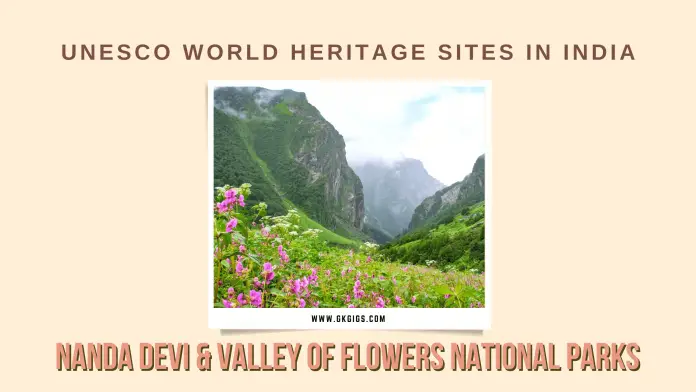
| No. | Header | Details |
|---|---|---|
| 1 | Inscription | 1988 |
| 2 | Location | Chamoli District, Uttarakhand |
| 3 | Boundary Modification | 2005 |
| 4 | Includes | 1) Nanda Devi National Park 2) Valley of Flowers National Park |
| 5 | UNESCO Criteria | Natural: (vii) (x) |
| 6 | Property | 71,210 ha |
| 7 | Buffer Zone | 514,857 ha |
| 8 | Dossier | 335bis |
| 9 | Description | Different types of high-altitude habitats exist, from high mountain peaks (Nanda Devi, at 7,817 m (25,646 ft) is India’s second highest mountain) to alpine meadows. Nanda Devi NP was originally listed alone in 1988, and the Valley of Flowers NP was added in 2005. |
30Qutb Minar
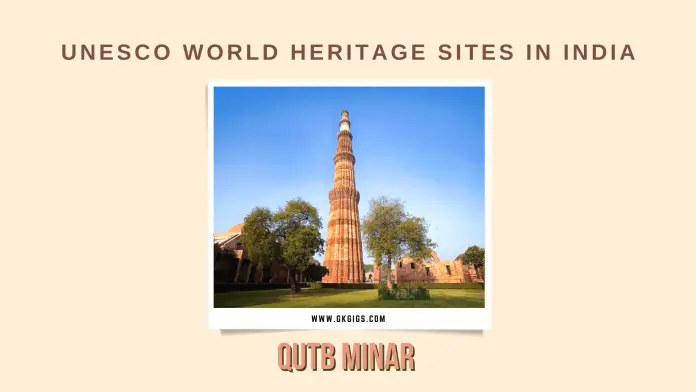
| No. | Header | Details |
|---|---|---|
| 1 | Inscription | 1993 |
| 2 | Location | Mehrauli, Delhi |
| 3 | UNESCO Criteria | Cultural: (iv) |
| 4 | Dossier | 233 |
| 5 | Description | The complex includes the Qutb Minar, a 72.5 m (238 ft)-high minaret, the Alai Darwaza gateway, the Quwwat-ul-Islam Mosque where several stone pillars from previous Hindu temples were repurposed, the Iron pillar, and several tombs and other monuments. |
Related: List Of Olympic Games With Fun Facts & Demonstration Year
31Ramappa Temple
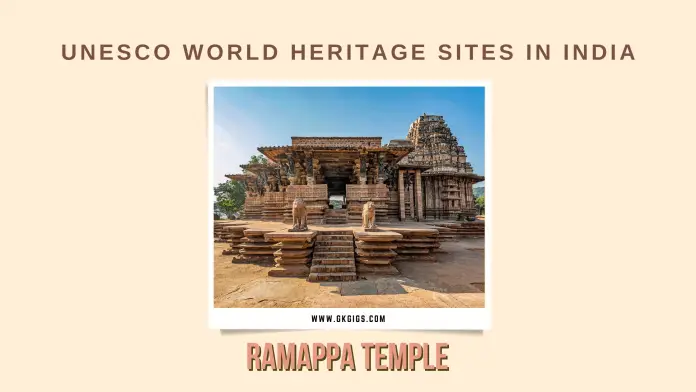
| No. | Header | Details |
|---|---|---|
| 1 | Inscription | 2021 |
| 2 | Location | Palampet Village, Mulugu District, Telangana |
| 3 | Affiliation | Hinduism |
| 4 | Deity | Shiva as Ramalingeswara Swamy |
| 5 | Festivals | Maha Shivaratri |
| 6 | Architect | Ramappa |
| 7 | Type | Kakatiya Architecture, Bhumija/Vesara style |
| 8 | Creator | Recharla Rudra |
| 9 | Completed | 13th Century |
| 10 | Direction of Façade | East-Facing |
| 11 | Official Name | Kakatiya Rudreshwara (Ramappa) Temple, Telangana |
| 12 | UNESCO Criteria | Cultural: (i) (iii) |
| 13 | Property | 5.93 ha |
| 14 | Buffer Zone | 66.27 ha |
| 15 | Dossier | 1570 |
| 16 | Description | The place is decorated with stone carvings and sculptures in granite and dolerite that depict regional dance customs. In line with Hindu practices, the temple is constructed in a way that blends harmonically with the environment. |
32Rani-ki-Vav
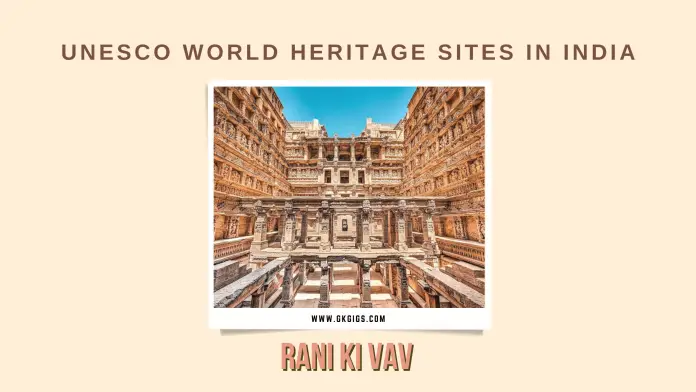
| No. | Header | Details |
|---|---|---|
| 1 | Inscription | 2014 |
| 2 | Location | Patan, Gujarat |
| 3 | UNESCO Criteria | Cultural: (i) (iv) |
| 4 | Property | 4.68 ha |
| 5 | Buffer Zone | 125.44 ha |
| 6 | Dossier | 922 |
| 7 | Description | It consists of seven levels, each of which is decorated with stone carvings and sculptures, depicting religious and secular themes and literary works. |
33Red Fort
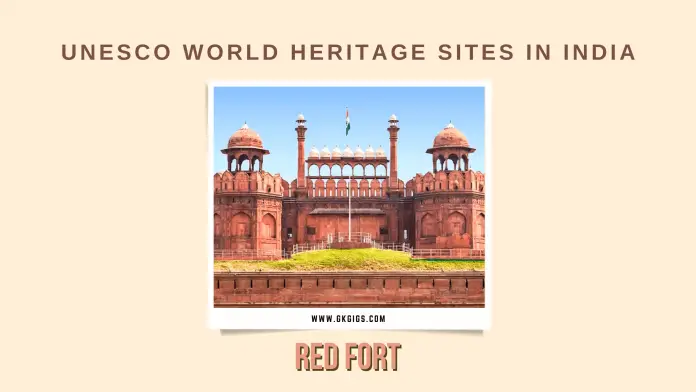
| No. | Header | Details |
|---|---|---|
| 1 | Inscription | 2007 |
| 2 | Location | Old Delhi, Delhi |
| 3 | Height | 18–33 m (59–108 ft) |
| 4 | Built | 12 May 1639 – 6 April 1648 |
| 5 | Architect | Ustad Ahmad Lahori |
| 6 | Architectural Style | Indo-Islamic, Mughal |
| 7 | Owner | 1) Mughal Empire (1638–1771) 2) Maratha Empire (1771–1803) 3) British India (1803–1947) 4) Government of India (1947–present) |
| 8 | Official Name | Red Fort Complex |
| 9 | UNESCO Criteria | Cultural: (ii) (iii) (vi) |
| 10 | Property | 49.1815 ha |
| 11 | Buffer Zone | 43.4309 ha |
| 12 | Dossier | 231rev |
| 13 | Description | The Red Fort was the setting of historical events, it was sacked and partially repurposed by the British, and it was the site where the independence of India was first celebrated. |
34Rock Shelters of Bhimbetka
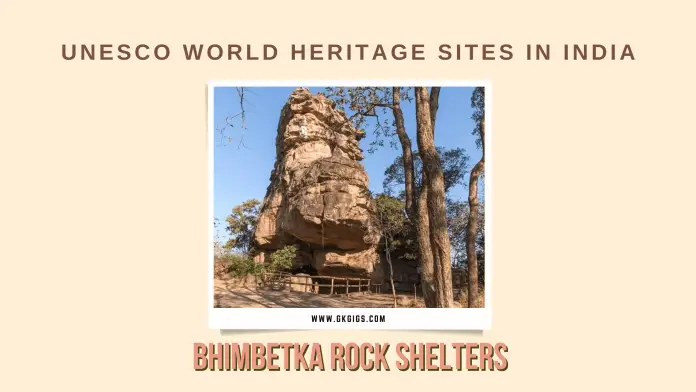
| No. | Header | Details |
|---|---|---|
| 1 | Inscription | 2003 |
| 2 | Location | Raisen District, Madhya Pradesh |
| 3 | UNESCO Criteria | Cultural: (iii) (v) |
| 4 | Property | 1,893 ha |
| 5 | Buffer Zone | 10,280 ha |
| 6 | Dossier | 925 |
| 7 | Description | This site comprises five clusters of rock shelters in the foothills of the Vindhya Range. They contain rock paintings from the hunter-gatherer societies of the Mesolithic to the historical period. |
35Sun Temple
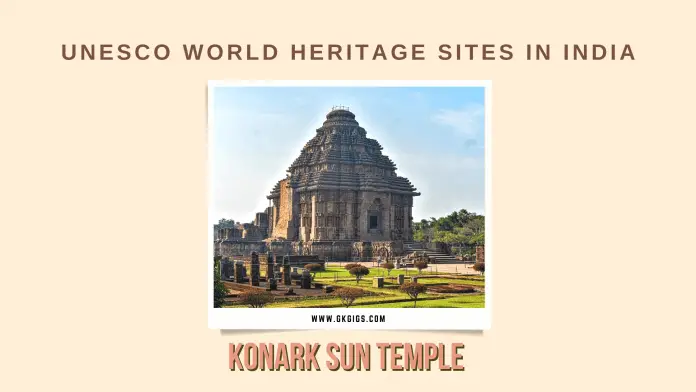
| No. | Header | Details |
|---|---|---|
| 1 | Inscription | 1984 |
| 2 | Location | Konark, Puri District, Odisha |
| 3 | Affiliation | Hinduism |
| 4 | Deity | Surya |
| 5 | Festival | Chandrabhaga Melan |
| 6 | Governing Body | ASI |
| 7 | Style | Kalinga |
| 8 | Creator | Narasimhadeva I |
| 9 | Completed | 1250 CE |
| 10 | UNESCO Criteria | Cultural: (i) (iii) (vi) |
| 11 | Property | 10.62 ha |
| 12 | Dossier | 246 |
| 13 | Description | It represents the chariot of the solar deity Surya: on the outer sides, it has 24 wheels, carved of stone and richly decorated, and it is pulled by six horses. |
Related: List Of Female Chief Ministers In India (2025 Updated)
36Sundarbans National Park
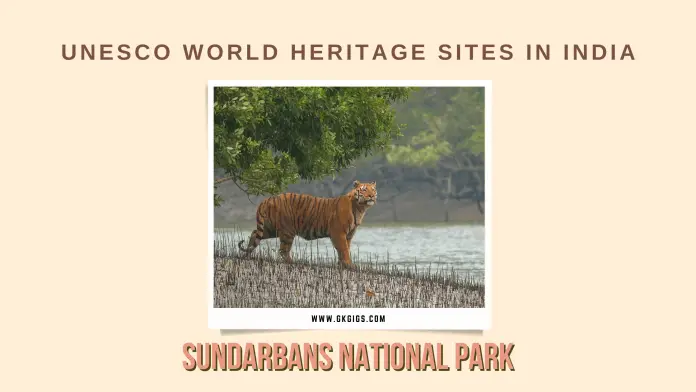
| No. | Header | Details |
|---|---|---|
| 1 | Inscription | 1987 |
| 2 | Location | South 24 Parganas, West Bengal |
| 3 | Area | 1330.10 km2 |
| 4 | Established | 1984 |
| 5 | UNESCO Criteria | Natural: (ix) (x) |
| 6 | Property | 133,010 ha |
| 7 | Dossier | 452 |
| 8 | Ramsar Wetland Designation | 30th January 2019 |
| 9 | Ramsar Wetland Official Name | Sundarban Wetland |
| 10 | Reference | 2370 |
| 11 | Governing Body | Government of India |
| 12 | Description | Sundarbans National Park is the world’s largest and richest mangrove forest, with about 78 recorded mangrove species. It is a biodiversity hotspot, home to a large population of Bengal tigers as well as an important habitat for the Irrawaddy dolphin and Ganges river dolphin. In Bangladesh, the Sundarbans is listed as a separate World Heritage Site. |
37Taj Mahal
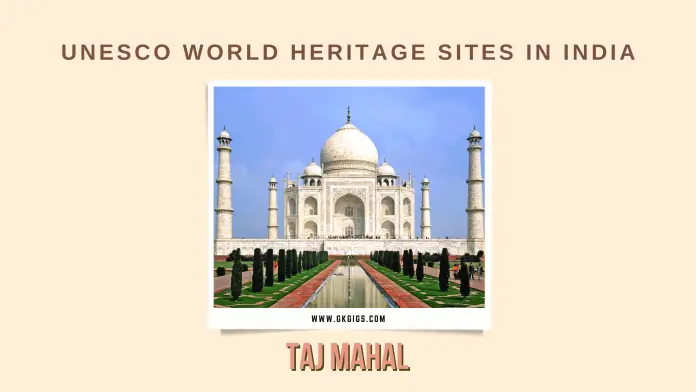
| No. | Header | Details |
|---|---|---|
| 1 | Inscription | 1983 |
| 2 | Location | Agra, Uttar Pradesh |
| 3 | Area | 17 hectares (42 acres) |
| 4 | Height | 73 m (240 ft) |
| 5 | Built | 1631–1653 |
| 6 | Built For | Mumtaz Mahal |
| 7 | Architect | Ustad Ahmad Lahauri |
| 8 | Architectural Style | Mughal Architecture |
| 9 | Governing Body | Government of India |
| 10 | UNESCO Criteria | Cultural: (i) |
| 11 | Dossier | 252 |
| 12 | Description | The Taj Mahal is the finest example of Indo-Islamic architecture. It was built in Agra on the bank of the Yamuna river as a mausoleum of Mumtaz Mahal, the Persian wife of the Mughal emperor Shah Jahan, between 1631 and 1648. |
38The Architectural Work of Le Corbusier

| No. | Header | Details |
|---|---|---|
| 1 | Inscription | 2016 |
| 2 | Location | Chandigarh, Chandigarh Capital Region |
| 3 | Includes | 17 Sites on Three Continents |
| 4 | Part Of | The Architectural Work of Le Corbusier, an Outstanding Contribution to the Modern Movement |
| 5 | Includes | 1) Palace of Assembly 2) Secretariat Building 3) Punjab and Haryana High Court 4) Open Hand Monument |
| 6 | Area | 66 ha (0.25 sq mi) |
| 7 | UNESCO Criteria | Cultural: (i) (ii) (vi) |
| 8 | Property | 98.4838 ha |
| 9 | Buffer Zone | 1,409.384 ha |
| 10 | Dossier | 1321rev |
| 11 | Description | This transnational site (shared with Argentina, Belgium, France, Germany, Switzerland, and Japan) encompasses 17 works of Franco-Swiss architect Le Corbusier. |
39Victorian Gothic and Art Deco Ensembles of Mumbai
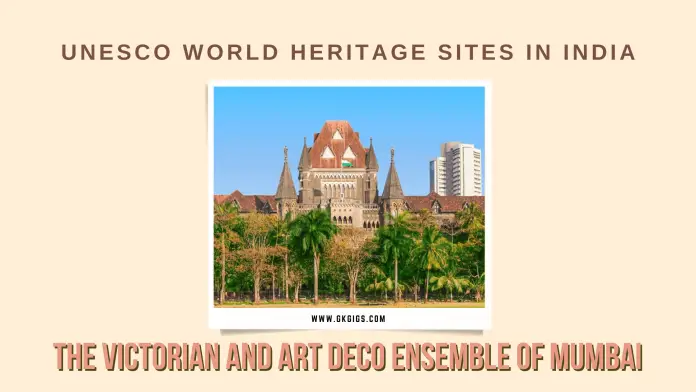
| No. | Header | Details |
|---|---|---|
| 1 | Inscription | 2018 |
| 2 | Location | Mumbai, Maharashtra |
| 3 | UNESCO Criteria | Cultural: (ii) (iv) |
| 4 | Property | 66.34 ha |
| 5 | Buffer Zone | 378.78 ha |
| 6 | Dossier | 1480 |
| 7 | Description | Public buildings in the Victorian Gothic style from the second half of the 19th century adapted Gothic Revival elements for the Indian climate, introducing features such as balconies and verandas. |
40Western Ghats
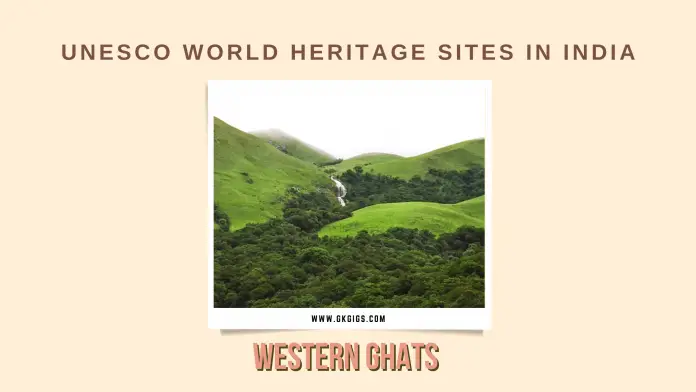
| No. | Header | Details |
|---|---|---|
| 1 | Inscription | 2012 |
| 2 | Location | 1) Gujarat 2) Maharashtra 3) Goa 4) Karnataka 5) Kerala 6) Tamil Nadu |
| 3 | Region | Western & Southern India |
| 4 | Biome | Tropical rainforests & Marshes |
| 5 | Age of Rock | Cenozoic |
| 6 | Type of Rock | Basalt, Laterite, & Limestone |
| 7 | Highest Peak | Anamudi, Eravikulam National Park |
| 8 | Elevation | 2,695 m (8,842 ft) |
| 9 | Length | 1,600 km |
| 10 | Width | 100 km |
| 11 | Area | 160,000 km2 |
| 12 | UNESCO Criteria | Natural: (ix) (x) |
| 13 | Property | 795,315 ha |
| 14 | Dossier | 1342rev |
| 15 | Description | The area is a biodiversity hotspot and home to endangered species such as the Bengal Tiger, Dhole lion-tailed macaque, Nilgiri tahr, and Nilgiri langur. |
| Read More |












